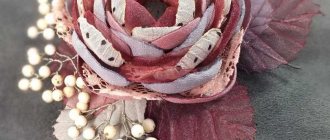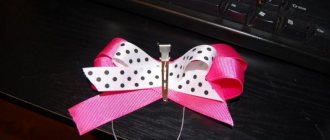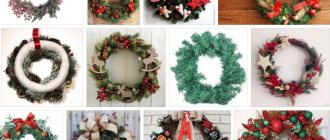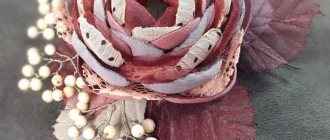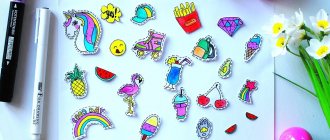I would like to devote today’s article to a very broad and popular topic – master classes on kanzashi leaves. In almost every flower arrangement we use leaves, sometimes very small, barely noticeable, sometimes large, to add volume to the work, sometimes to hide any imperfections. In any case, you need different leaves, large and small, simple and intricate. I have put together this selection so that you have a choice of which leaves to diversify your flower arrangement.
We will make leaves from ribbons 5 cm and 2.5 cm wide.
Simple kanzashi leaves
In the first tutorial we will make simple and universal leaves from 2.5 cm ribbons that will suit almost any kanzashi flowers. Let's take a green satin ribbon, I won't cut it into pieces to show that the petals can be made of any size. Turn the ribbon inside out towards you, bend the left edge at an angle of 90 degrees and place the right edge of the ribbon over it. The result is an angular petal.
Let's cut the ribbon and make two folds at the base, fix them by melting them over the fire.
How to make a maple leaf from ribbons step by step
1. Start making your planned autumn kanzashi with triple sharp petals. For them, take red, orange and gold squares with a side of 5 cm.
2. For one petal you need all the squares of the indicated colors. Bend each one diagonally.
3. Place the orange triangle on top of the red one and add a layer of gold between them.
4. Round the multi-layer triangle by closing the sharp corners, singeing them. Trim the bottom of the petal to make it flatter.
5. For the inside of the petals, prepare a gold satin and lurex ribbon - squares with a side of 2.5 cm.
6. Fold the indicated pair in half diagonally.
7. Place the shiny triangle on the satin one and start folding the double corners.
8. Form a diamond with a bright layer in the center.
9. Use a clamp to secure the bottom corners, rounding the top. You should get a golden droplet petal.
10. On the reverse side, the excess edge of the tape should be trimmed.
11. For the central flower, prepare 6 triple petals and the same number of droplets.
12. Make similar details for the outer part of the maple leaf. Form triple petals using orange and gold satin ribbon and gold lurex. Make single kanzashi petals from small red squares.
13. Insert small rounded petals intended for the central flower into the middle of the large ones. Gather the flower on a string. Glue a 1.2 cm red half bead into the center.
14. Make 11 petals for the outer part of the leaf. Insert small red petals inside the triple ones.
15. Leave two petals unchanged and glue small half-beads to them. Glue the remaining 9 into branches, combining 3 parts. Also decorate the resulting blanks with half beads.
16. Glue the resulting branches into the voids between the flower petals.
17. From 2.5 cm gold lurex fabric, make 3 small sharp petals.
18. Small parts are designed to disguise the places where branches are attached.
19. Take wire and thin gold ribbon.
20. Wrap the ribbon around the wire and glue it to the back of the flower. Also glue on the little gold pieces. Cover the entire structure from behind with a felt circle.
The maple leaf made from ribbons is ready. All that remains is to think about the purpose of the product and choose a base. The size of the finished decoration is 8*10 cm without the stem.
Content
Leaves for kanzashi flowers
From a piece of 2.5x10 cm we will make two types of leaves. To do this, fold the segment in half (with the front side facing you). Apply a metal ruler diagonally and cut the tape into 2 parts. We will get 2 different leaves.
Let's make thin long leaves from the part we made in the previous tutorial.
— Part 2Autumn leaves made of fabric
12.12.2014
Author: Administrator
- Photo 8. Place the solution on the fire until the gelatin granules are completely dissolved, without bringing to a boil. Place the tissue in a gelatin solution.
- Photo 9. Dry the fabric in one layer.
- Photo 10. Using templates, we cut out the leaves and make veins on a soft surface with a cold knife.
- Photo 13. Prepare the hairband: first we braid it with a ribbon, then glue the ribbon on top in waves. This will add splendor to the wreath. Glue the leaves to the rim in any order.
Share the link to the post on social networks ↓
kollekcija.com
Narrow ribbon leaves 2.5 cm
Let's take the leaf we made earlier by the base, so that the edges rise, now we lower them down, making a fold on both sides and fold the rest of the tape up again.
Let's melt the base.
Now we will make leaves from ribbons 5 cm wide.
Master class handicrafts. Ribbon leaves.
Today I will tell you how to make beautiful leaves from satin ribbons. I will show two options for leaves. They are made quite quickly and very harmoniously complement flower arrangements.
I was very interested in flowers and somehow paid little attention to the leaves. But they are the ones who give flower arrangements a finished look. They “revive” and add color to products. And what to be disingenuous - they often hide some defects and the reverse side of the products, as a result of which we get jewelry that is perfect both from the front and from the back.
I use these leaves most often in my products. I offer you a master class - leaves from ribbons.
To make these leaves we will need: 1. Green satin ribbon 2.5 cm wide. 2. Burner or simple kitchen knife 3. Metal ruler 4. Glass or glass cutting board 5. Sewing supplies
Let's get started.
Cut the ribbon into 10 cm long pieces.
Let's put the ribbon on the glass. Next, fold the strips in half, wrong side inward.
Place the ruler on the tape diagonally.
We cut the ribbon along the ruler with a burner or a hot knife.
We have one leaf ready. If desired, the bottom part can be turned out. I prefer to leave these leaves unchanged.
Here is an example of using these sheets. MK flowers can be viewed here.
We still have the top part of the tape. We won't throw it away. We will also make beautiful leaves from it.
We cut off the bottom part with a burner so that it becomes even.
We collect the bottom of the future leaf on a thread.
We tighten the thread, fasten it and cut it. The leaf is ready.
I used these leaves to make a wreath.
Good luck in your creativity and new ideas.
Kanzashi leaves from a wide ribbon
Fold a 5x10 cm piece in half (with the front side facing you), apply a metal ruler from the bottom edge of the tape to the center of the top part and cut it with a soldering iron or burner.
We also cut the leaf from the other edge, so we get two leaves “with a pocket.” We don’t throw away the blank that remains from the leaves; we will also make a leaf from it.
Let's make a leaf from the blank that was left over from the previous master class.
Autumn leaves made of fabric
Author: Administrator
Autumn leaves made of fabric
- To create the wreath, I used 2 types of leaves: those treated with gelatin solution and those not treated, so all the leaves turn out different both to the touch and visually, which makes the wreath look realistic and lush.
- So, master class “Do-it-yourself autumn leaves from fabric.”
- Photo 1-2. Draw leaves on cardboard and cut them out. These will be patterns.
- Photo 3. Using patterns, transfer the leaves to fabric or tape.
- Photo 4. Cut out the leaves.
- Photo 5-6. We singe the edges of the sheet and make veins.
- Photo 7. Prepare gelatin solution: 1 tbsp. spoon of gelatin and 1 tbsp. spoon of water.
CLICK THE ARROW BELOW to read more...
kollekcija.com
Kanzashi leaf with folds
Cut off one melted edge of the workpiece and cut the base to create an open part.
We process the edges with a lighter and pull them out a little, resulting in a slight waviness. At the base we also melt the tape with fire.
We make several folds, first on one side, then on the other. We melt the bottom of the leaf and “flatten it” with our fingers so that the base is flat. These leaves look great with strawberries.
The next master class is dedicated to rose leaves, I will make them double using glue and wire.
Video master class: making leaves for flowers from ribbon
I would like to share with you a master class on making leaves for kanzashi flowers. Using this method, you can make not only leaves, but also various products for decorating gifts, compositions from ribbons and not only from ribbons. I think that this method of making leaves will be useful to you in your creativity. You can find out all the details from this video master class.
Leaves for rose
Cut the satin ribbon into 5x7 cm pieces; 1 sheet will require 2 pieces. We apply glue to the wrong side, I use “Titanium”. Lay the wire diagonally and cover it with a second piece of satin ribbon on top. Smooth out the sheet, carefully highlight the wire, it serves as the central vein. When the glue dries, cut out the shape of a leaf from the workpiece and make notches.
Carefully process the edges of the sheet over the fire and while it is still hot, give it a slightly curved shape. Leaves can be of different sizes, shapes and textures. You can see how to use such leaves in a composition in MK on roses made from satin ribbons.
How to make leaves for a flower?
There are many types of leaves for flowers: simple and complex, large and small, voluminous and flat. Depending on the style of composition, the technique is determined, colors and quantities of materials are selected. The size of the finished sheet depends on the width of the tape, so tapes of any width are suitable for all methods.
Simple
From the name it is clear that this method is suitable for beginners. Simple petals are used in combination with any flowers. To make them you need:
- cut ribbons 5 cm wide into 10 cm rectangles, the length is equal to the width multiplied by two;
- singe the cuts over a candle;
- bend the top corners to the center of the bottom and secure with a pin;
- At the bottom, place a hand stitch “forward with the needle”, sewing both layers together;
- tighten the stitching and secure it;
- Sew the edges on the reverse side, the leaf is ready.
For a rose
To make leaves for a rose, you will additionally need wire and glue. They look beautiful and natural, and are made easily and quickly:
- cut a 5 cm wide tape into 7 cm pieces;
- coat the wrong side with glue and place a piece of wire diagonally and place a second piece on top;
- smooth out so that the wire stands out well, it will be the middle vein of the leaf;
- when the glue dries, cut out the shape of a leaf and make serifs;
- burn the edges over the fire and while the sheet is hot add curves to it for a natural look.
Important! It is advisable to use transparent glue that does not leave marks on the fabric.
Corrugated
For a textured sheet, a tape 5 cm wide is suitable:
- Cut it into 6 cm pieces and wet it with water.
- Fold it diagonally, inside out, so that the edges are aligned on one side.
- Place this piece between two layers of thin synthetic fabric, such as organza.
- Place a heated iron on top and, pressing it with one hand, roll the fabric under it.
- Then pull out the workpiece, unfold it and cut out the shape of the leaves.
- Finish the edges over the candle.
- The resulting corrugated leaves are used for various flower arrangements.
Important! The finished product should not be wet or wrinkled, otherwise it will lose its relief. To give it an aesthetic appearance, it is periodically sprayed with hairspray.
Big leaf
If you need a large leaf, then use two pieces of 25 mm tape, each 12 cm long. To make it you need:
- fold the two strips right side inward, cut the corner and melt the cut;
- sew a hand zigzag stitch to the bottom;
- pull together to form a tight gather;
- Sew gathered ribbons together along the wrong side and secure at the bottom.
Important! For crafts made from satin ribbons, synthetic materials are chosen so that the cut melts and does not burn.
How to finish the edge of a skirt with satin trim
Beautiful styles of corduroy dresses
Corrugated leaves
Unusual textured leaves from satin ribbons are obtained if it is pre-corrugated. To do this, we use a satin ribbon measuring 5x7 cm, moisten it with water. Fold it diagonally with the front side facing you.
We need thin synthetic fabric, I use a piece of organza. I wrap the piece of tape in it and put an iron on top, heated on the second level. I take the edge of the organza and, pressing on the iron with one hand, I scroll the organza under the iron. As a result of such manipulations, an interesting relief is obtained.
We cut out the shape of a sheet from the blank, make small notches and process the edges with a lighter. The result is leaves that can be used for any kanzashi flowers.
Another option for making leaves for flower arrangements.
Leaf for tulips
2.
Take the satin ribbon and fold it right side inward (it turns out to be a square).
3.
Then cut diagonally. We've got our first leaf. Here I used a soldering iron to cut the square, but you can do all this with scissors and a lighter, as you prefer.
4.
In order to save material, I also cut off one triangle and this will be another leaf.
5.
The next step is to cut off the tip of the receding triangle.
6.
Turn it inside out and burn the edges with a lighter.
7.
The leaf is ready)))
Large sheet with folds
We use 2.5 cm tape, 12 cm long; 1 sheet will require 2 pieces. Place the pieces together with the right sides facing inward. Cut the corner and melt the cut.
We will make 5 folds on both sides and secure them with pins. From the wrong side we sew both ribbons.
Fold the sheet at the base and melt it with fire. Iron the leaf so that the folds lie evenly and do not puff up. These leaves are more suitable for voluminous flowers such as chrysanthemums, asters or dahlias.
DIY silk wreath “Autumn Leaves”. Master Class.
So autumn has come. Such bright colors in the forest, you won’t find any colors and shades.
And while collecting leaves with my daughter, I came up with an interesting idea to make a wreath of autumn leaves, because... I have summer wreaths, but no autumn wreath. After all, this is an ideal decoration for a wedding in the fall and for a photo shoot in a forested area.
Shall we begin?
For work we will need the following - satin silk with factory impregnation or self-impregnation, tools for flower making (2nd knife, 1st knife, small boule), medium hard pillow, aniline paints, palette, brushes, water, letons No. 28 (wire wrapped with corrugated paper) , PVA glue, scissors, brown silk ribbon.
We cut out an arbitrary number of maple and oak leaves; templates can be found on the Internet of any desired size. My leaves are not large: maple leaves are about 7 cm, oak leaves are about 4 cm, and there will also be birch leaves, but we will cut them out of painted satin.
Now let's mix the colors. Add water to the palette and add paints drop by drop, mixing the colors. I have five shades - grass green, dark green, orange, wheat and red.
We lay out our cut out leaves on a newspaper and soak them well with a brush dipped in water, then paint them as you see autumn leaves. Mine turned out like this. For birch leaves, take a rectangle of satin ~ 15/8 cm and paint it entirely dark green, making various stains with orange and red paint. After painting, transfer it to dry newspaper and wait for it to dry completely.
After drying, each leaf can be ironed without steam to make the leaves even. Now you need to glue the letons to the leaf, measure it, grease it with PVA glue and glue it.
Glue letons to all the leaves. We also glue 10 pieces of letons to the painted satin rectangle. for 10 leaves, cut out making cloves on the edges.
Now we heat up our tools 2nd knife and 1st knife. In the middle, where the leton is on the front shiny side, we make a vein with a 2nd knife. Using a single drawing we will draw veins along the entire leaf.
Also, on a birch leaf, use a 2nd knife to make a central vein, and 1m along the edges of the leaves. See photo. Repeat with the remaining leaves.
Now we change the 1st knife in the soldering iron to a small loaf (ball), and make the central vein of our oak leaf from the face, with the same 2nd knife we make longitudinal veins, turn it inside out and press the edges of the leaf with the loaf. Repeat with the remaining leaves.
All leaves are ready and processed.
Now we will need - letons, PVA glue, brown ribbon, scissors and maybe someone wants to make not a wreath, but a headband, please, the assembly principle is the same.
Now, take 4 letons, fold them together, grease the edge of the tape with glue and begin to wrap the letons, make a loop, and continue wrapping, apply a birch leaf, drip glue onto the tape and wrap it.
We continue to apply leaf after leaf, do not forget to drip glue onto the tape to fix the leaf.
We wrap a maple leaf between the birch and oak leaves, and again do not forget to fix it with glue.
We continue to wind and periodically try on the volume of our wreath, about 53 cm. We also finish with a loop.
The wreath is ready. Now all that remains is to thread the ribbon through the loops and tie a beautiful bow.
Is the wreath really good? Light, autumnal, enchanting.
Thank you for watching the autumn magic! I will be happy to answer questions and comments.
Sincerely, Elena!

